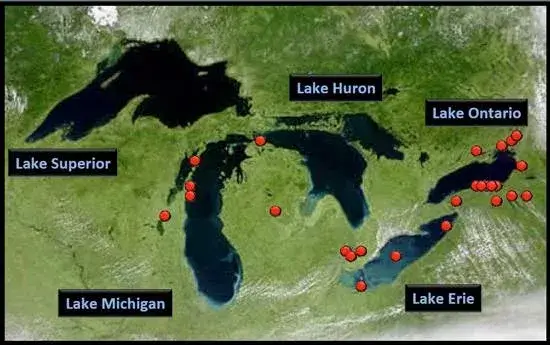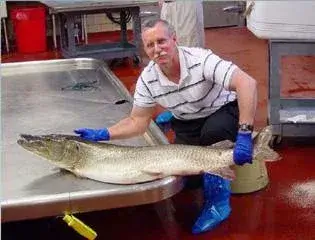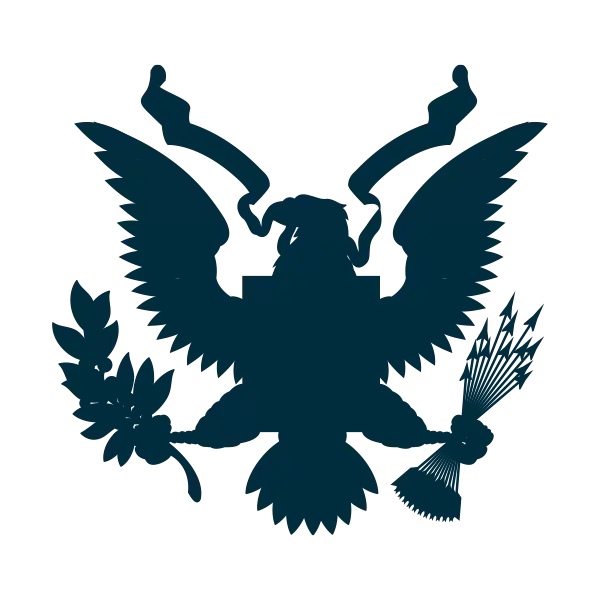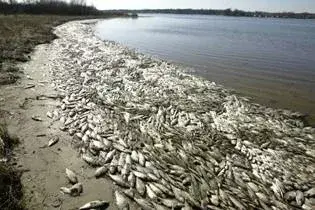
Viral hemorrhagic septicemia or VHS (Novirhabdovirus sp.) is a serious disease of fresh and saltwater fish, both in the wild and those raised for commercial aquaculture. VHS is caused by an aquatic rhabdovirus. The VHS virus is native to eastern and Western Europe (where it has affected cultured rainbow trout), the Pacific coast from California to Alaska (in Pacific herring and cod), and the Atlantic coast of North America (in Atlantic herring and Greenland halibut). The actual vector for the virus’s introduction into the Great Lakes is unknown. It is suspected that it may have been transported in ballast water or by migratory fishes from the Atlantic coast. It is possible that baitfish harvesting and movement, recreational boating and angling, as well as aquaculture activities are responsible for the spread of the virus since it arrived in the Great Lakes. Waterfowl may also play a role.
The virus is believed to have been present in Great Lakes muskellunge in Lake St. Clair since 2003. In 2005, several hundred tons of freshwater drum, muskellunge and round gobies died of VHS in Lake Ontario. Since that time, VHS-related fish kills of black crappie, bluegill, burbot, freshwater drum, gizzard shad, lake whitefish, muskellunge, northern pike, redhorse sucker, rock bass, round goby, smallmouth bass, white bass, yellow perch, and walleye have been confirmed in Lakes Erie, Huron, Michigan and Ontario, and the Niagara and St. Lawrence Rivers. Inland sightings of the virus in New York include Conesus and Skaneateles Lakes, the Seneca-Cayuga Canal, and a private pond in Ransomville (Niagara County).

In its most acute form, VHS can cause hemorrhaging in the eyes, skin, gills, fin bases, skeletal muscle and internal organs, leading to high mortality rates. Infected fish may become hyperactive and display such symptoms as swimming in circles or in a corkscrew pattern, sometimes accompanied by a twisting of their bodies. In its chronic form, the disease results in similar symptoms except that fluid accumulation in the organs replaces hemorrhaging and mortality rates are lower. There is no cure. Fish that survive infection with the VHS virus can carry the virus for the rest of their lives, often with no symptoms, spreading the disease and infecting additional fish. Not all infected fish show symptoms but may be carriers of the disease. VHS does not pose a threat to human health.
Almost 50 species of fish are known to be susceptible to VHS, including such commercially and recreationally important species as brook trout, Chinook salmon, lake trout, rainbow trout, walleye, smallmouth bass, northern pike, yellow perch, and muskellunge. The virus has also been found in bluntnose minnows, Chinook salmon and emerald shiners but has not resulted in die offs of those species. The ultimate potential impact of VHS on North American fisheries is still unknown, but there is the potential for significant fishery, angling, tourism, and economic consequences.

VHS can be spread from one waterbody to the next through a variety of means, not all of which are known at this time. One known vector is moving fish from one waterbody to another by importation, stocking, or bait fish transport. Other potential transmittal vectors are natural fish movements, recreational boating/angling, waterfowl, ballast water discharge, and lake resource sampling activities.

Anglers and boaters can reduce the likelihood of their spreading VHS from waterbody to waterbody by adhering to the following guidelines:

In order to prevent or delay the spread of VHS to other states, APHIS (the Animal and Plant Health Inspection Service) prohibits the importation of certain species of live fish from the Canadian provinces of Ontario and Quebec and interstate movement of the same species from Illinois, Indiana, Michigan, Minnesota, New York, Ohio, Pennsylvania, and Wisconsin. (The Federal Order was issued on October 24, 2006.)
The species included in the federal prohibition are: black crappie, bluegill, bluntnose minnow, brown bullhead, brown trout, burbot, channel catfish, chinook salmon, emerald shiner, freshwater drum, gizzard shad, lake whitefish, largemouth bass, muskellunge, northern pike, pumpkinseed, rainbow trout, rock bass, round goby, silver redhorse, smallmouth bass, trout perch, walleye, white bass, white perch, and yellow perch.
The New York State Department of Environmental Conservation finalized fish health regulations to prevent the spread of VHS in the inland waters of the state. These regulations include such actions as prohibiting the transport of fish from one body of water to another and restricting the use of baitfish to the waterbody from which they were harvested unless certified as VHS free.
Bain et al. 2010. Distribution of an Invasive Aquatic Pathogen (Viral Hemorrhagic Septicemia Virus) in the Great Lakes and Its Relationship to Shipping. PLoS ONE. April 2010 | Volume 5 | Issue 4 | e10156. http://www.plosone.org/article/info%3Adoi%2F10.1371%2Fjournal.pone.0010156
Elsayed, E., Faisal, M., Thomas, M., Whelan, G., Batts, W., and J. Winton. 2006. Isolation of viral haemorrhagic septicaemia virus from muskellunge, Esox masquinongy (Mitchill), in Lake St. Clair, Michigan, USA reveals a new sublineage of the North American genotype. Journal of Fish Diseases 29: 611–619.
